The Basis for Korean Design in the Past
There is a belief originated from China and shared in the Orient called "yin-yang and the five elements theory", or eumyangohaeng in Korean. Old East Asian culture and its people’s lives were deeply based on nature, and the theory explains the natural system which the world is founded on. Yin-yang or eumyang means light and darkness, which are represented by the sun and the moon. Ohaeng means the five elements; fire, water, tree, metal or gold, and earth, which compose the world we live in.
Yin-yang and the five elements theory symbolizes and provides interpretations for parts of the universe, such as colors, positions, and time (weather). The five basic colors, called obangsaek - red, black, blue, white, and yellow - are colors that represent each of the five elements from fire to earth, in order. These colors also symbolize five positions - south, north, east, west, and the center. Then, the four positions - east, south, west, and north - correspond to each season- spring, summer, fall and winter. Though the basic five colors are also the traditional colors of China and Japan, they have different hues, meanings and usages in Korea.

The Five Traditional Colors and their Variants
The colors of obangsaek have each of its own significations. Red, symbolizing creation, passion and love is conceived to be a powerful color that wards off evil spirits. This belief is the reason why Koreans eat red bean soup on the day of the winter solstice. Black stands for wisdom, darkness, and death. Since black indicates death, the color is rarely used in palaces. However, judges wore black to embody honesty and honor. Blue signifies new birth, brightness, and clarity. Blue is typically used in clothes of maidens and vassals in palaces. The bride’s dress and thread decorations hung in marriage ceremonies are also in red and blue. White, meaning truth, life and virginity, is the color that is loved by Koreans the most. Koreans liked to wear white clothes, and called themselves the “white-clad folk”. Finally, yellow or gold represented brightness and rays of sunlight. Gold ropes are used to mark holy sites and places that need protection, such as the house where a mother just gave birth to a child.
Ogansaek is another set of five colors that are made from the combination of each of the colors of obangsaek. Two obangsaek colors are mixed to make ogansaek colors; green (yellow+blue), light blue (blue+white), bright red (red+white), sulphur yellow (yellow+black), and violet (red+black). Though obangsaek is more representative than ogansaek as Korea's traditional colors, they are used harmoniously in traditional Korean design.

(Photo courtesy of http://cafe.naver.com/colorsun/65688)
How the Colors are Used Together
Obangsaek and ogansaek are widely employed on hanbok, a traditional Korean outfit, and on food and architecture. Saekdong jeogori, a type of hanbok worn by children, is adorned with saekdong, stripes of many colors. Colors of obangsaek and ogansaek are used to make saekdong, which is believed to drive away bad luck and bring good fortune. A lot of Korean foods make use of the colors as well. The most well-known of these foods is bibimbap, rice mixed with vegetables and meat, which the colors of the ingredients are beautifully arranged. Dancheong, which are patterns such as animals, plants and geometric shapes that embellish wood structures, is painted in obangsaek and ogansaek. The colorful patterns emanate mystique and express the dignity and authority of important structures, too.



(Photos courtesy of http://sula.kr/xe/7962,http://sweetcook.tistory.com/, https://pixabay.com/ko/ )
Nowadays, it is difficult to find materials composed of obangsaek and ogansaek. However, the colors remain as motifs for contemporary Korean artworks and symbols. Korea's flag is composed of red, blue, white, and black, which are colors of obangsaek. In addition, the former symbol and motto of the City of Seoul, 'Hi Seoul', was composed of red, yellow, green and blue. Although not as widespread as the past, obangsaek and ogansaek still live on to influence Korean lifestyle.
Jang Soo-hyun
luxkari@hanyang.ac.kr
키워드
인터넷한양
cosmos3rd@hanyang.ac.kr


 '한양위키' 키워드 보기
'한양위키' 키워드 보기